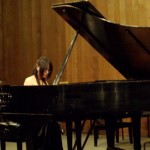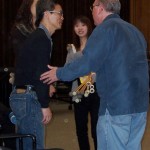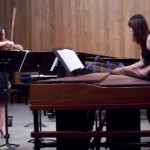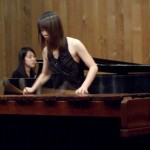It was like having a recital the same night as the Academy Awards. That’s what happened to Idyllwild Arts music students, Una and Meiling, two juniors. Last night, Friday, May 29, was the same night of the student film screenings where they rolled out the red carpet, and the audience line went clear down the parking lot.
However, those friends, family members and faculty who came to Una and Meiling’s recital, got to witness “pure entertainment.”
You knew it the moment you walked into Stephens Recital Hall. Set up before us was a marimba, four kettledrums, and a snare-bass-drum-cymbals combo set. These large percussion instruments dwarfed everything around them, including Una, who weighs about 90 pounds.
Yet, she obviously knew how to command these instruments. For Una’s first piece, “Furioso and Valse in D Minor,” by Hatch, she performed solo, hitting the large wooden marimba keys with her mallets.
For those of us who didn’t know until tonight, a marimba is a musical instrument in the percussion family. Keys or bars (usually made of wood) are struck with mallets and are arranged like those on a piano, with the accidentals raised vertically and overlapping the natural keys.
Marimbas originated in Africa hundreds of years ago and were imported to Central America in the sixteenth century. Needless to say, it’s a very large instrument, but it produces a soft, wooden and metal sound.
For her next piece, “Sonata for Marimba and Piano,” by Tanner, Una was accompanied by her classmate, Keri. Like many instruments that are generally the “backbone” of the orchestra, and never out in front, this was a nice piece. Keri’s piano didn’t drown out the marimba, in which Una played with two mallets in each hand. And Una had many moments in which the piano wasn’t playing.
Next, Una came out and stood behind the four large timpani drums. They looked like oversized copper metal pots covered with soft leather tops. You knew immediately that the sound coming from them would be commanding–and it was. It sounded like a jungle movie in which something was going to happen soon.
In a rare moment at Idyllwild Arts, brother and sister got to play together at the same recital. For this piece “Solo Impression for Four Timpani,” by Firth, Una was accompanied by her older brother, Rich, on piano. His piano part was frenetic sounding and sporadic, while Una’s drumming built up to a crescendo.
Although the timpani piece was a short one, two people in the audience couldn’t have enjoyed it more: their parents.
That night, Una wasn’t without accompanists. For her next piece, “Three Oranges,” by Hoffman, she was joined by Stephanie, a violinist, who is also Rich’s girlfriend. Una played the marimba, while Stephanie “plucked” at her violin. The overall effect sounded like harp music. Naturally, the song lead to larger sounds by both instruments. At times, Una used double mallets to get a larger sound.
For her final piece, “The Love of L’Histoire,” by DeLancey, Una changed instruments again. This time, she played the snare-bass-drum combo. In addition to the drums, there was also a wooden piece that sounded like horse clomping, a cowbell, and cymbals. The title, “The Love of L’Histoire,” suggested a French patriotic sound, but it was more “New Age,” space-type music with irregular rhythms.
But when Una got going, her arms were outstretched, and she was pounding on the snare and bass drums at the same time. It looked difficult, but she pulled it off.
“You should have seen her at the ‘New Music’ orchestra concert,” said Andrew Leeson, a teacher in the Creative Writing Department. “It looked like her arms were stretched eight feet wide. It was amazing!”
Afterwards, Una took two bows and received a standing ovation. She also got flowers from her brother and his girlfriend.
Una is looking forward to returning to Idyllwild Arts this summer. She’s received a scholarship, and will have a chance to work with new teachers and percussion instruments.
After a brief intermission, it was Meiling’s turn. Many of her fellow piano students moved closer so they could see her fingerings on the piano.
For her first piece, she chose “Sonata K280 in F Major,” by Mozart. It started out fast, and Meiling played it loud and confidently. For the middle or “adagio” part, she played the piano more melancholy and quiet.
Her next piece included three preludes by Chopin, including “No. 1 in C Major,” “No. 3 in G Major,” and “No. 16 in B-Flat Minor.” The “No. 3 in G Major,” was the best of the three, because it was loud, intense, and I envisioned a flight of bumblebees.
For Meiling’s last piece, she was accompanied by Yifan, another pianist, on a grand piano set up next to hers. “Scenas Infantis,” or Memories of Childhood, by Pinto, included many familiar lullabies, including, “Ring Around the Rosy,” and “Sleeping Time.”
Although it sounded simple at first, it soon built into a nice, complex arrangement. And the dueling pianos gave it a commanding sound.
“She’s a good player,” said Ie-Seul, a senior pianist, who had played her Mozart and Chopin pieces, but didn’t know her final one.
After her second bow, Meiling received a hug from her boyfriend, Felix.
All in all, the instruments, the arrangements, were unexpected, and the musicians played with skill and confidence. It wasn’t the Academy Awards, but pure entertainment.

the attachments to this post:








